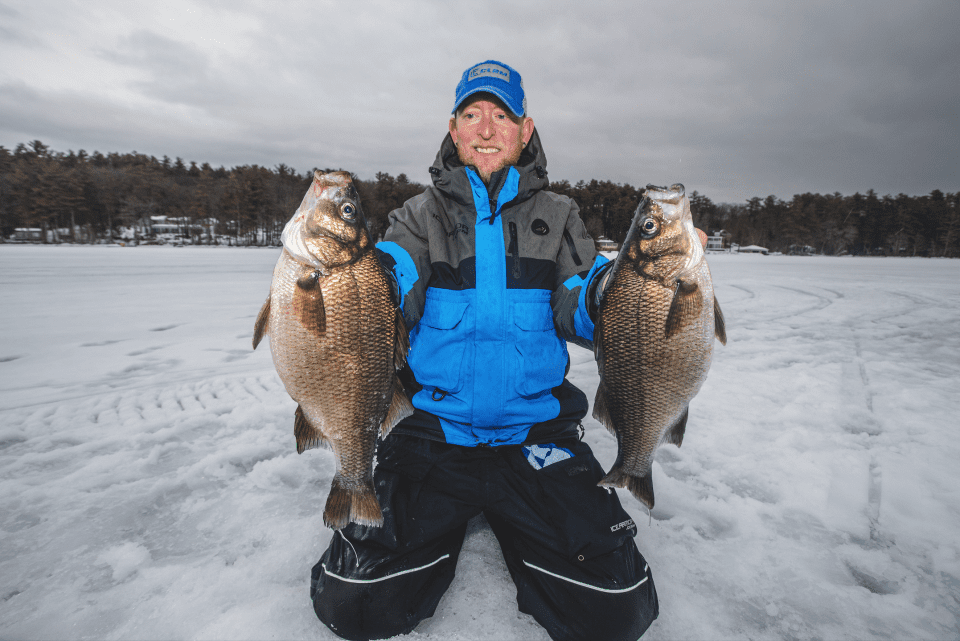Three Tips for Better Success This Winter
By Tim Moore
Ice anglers are always looking for an added edge, something that will help them put a few more fish on the ice. Many anglers search for the latest and greatest new products to help them catch more, while others look to increase their skill set. We love to learn new tactics that will help us become more successful. We scour magazines, watch videos online, and attend seminars looking to pick up any tips that will increase our ice fishing success. Sometimes, revisiting old techniques can help experienced anglers up their game, but even old techniques will always be new to someone. Here are a few tips that will hopefully help you catch more this season.
Stay on Top
There is nothing more exciting to most anglers than finding a school of fish so thick that their Vexilar can’t read through the school and reads the top of the school as the bottom of the lake. This normally means non-stop action, but what do you do when the school is so focused on one particular prey species that your lure practically disappears? A lure lost in a school of feeding fish sometimes resembles a needle in a haystack, it can literally disappear among the fish. If you keep your lure above the school, and fish it up and away from the fish where it looks isolated and vulnerable, you can usually persuade a fish to leave the school and investigate, or capitalize on what looks like weak or wounded prey. Staying above the school also allows you to see your lure on your fish finder, thus knowing how fish are reacting to it and what you should or should not do more of.
Find the Bite Ceiling
Light conditions often dictate where fish are in the water column, and how far off bottom they’re willing to go. On overcast days, ore early and late in the day, low-light conditions allow fish to see better. Better visibility often makes fish more actively feed. Barometric pressure is another factor that decides how far off bottom fish are willing to go. High pressure is uncomfortable on a fish’s swim bladder and typically equals less activity and a resistance to come off the bottom or away from structure and weeds. Energy conservation is another major factor that dictates the lengths fish will go for a meal. In my seminars I often use the analogy that if a candy bar dropped from the ceiling on a string when I am cold, tired, and/or full, I wouldn’t work very hard to get it. The similar idea holds true for fish. Some biologists use the 10% rule: If a fish cannot get back at least 10% of the energy from a meal that it uses to get it, then it often will not waste its time.
There is a limit to how high in the water column fish will want to travel in pursuit of food. You often hear this referred to as the bite ceiling. Knowing the bite ceiling can prove invaluable, especially after you pluck a few fish from a school and the rest begin to sense something is not right and become finicky. If you can get fish to follow your lure, keep working it up in the water column to the point that the fish stops following. Doing this a few times will help establish where the bite ceiling is. Kn
owing the bite ceiling gives you a more specific area of the water column to focus on. Time spent trying to persuade fish to travel farther than they are willing to go is time wasted. Establishing the bite ceiling will almost always produce better results.
Play the Keep-Away Game
Playing keep-away is one of the most effective techniques I employ when ice fishing. It accounts for more white perch, crappie, and lake trout landings on Lake Winnipesaukee than any other technique I have ever used. I understand that every day and each situation can be different, and while techniques such as dead-sticking can sometimes be extremely effective, most predatory game fish are accustomed to their prey attempting to flee when chased. Some species, such as lake trout, will often reject their prey if it stops trying to get away (for no reason) when they chase it. Keeping your lure moving slowly away from a fish that appears (on your flasher) to be committed can be a difficult technique to get used to, but it makes your presentation appear more natural and prevents the fish from getting a good look at it.
Most successful ice fishing aventures are the culmination of many small victories. Small tricks and tips can often turn a good trip into a memorable one. If you don’t already use one or more of these techniques, give them a try the next time you head out onto the ice. Alone they are extremely effective. Put them together and they often result in memorable days with far more fish on the ice, and in the frying pan.
Tim Moore is a full-time professional fishing guide in New Hampshire. He owns and operates Tim Moore Outdoors, LLC. He is a member of the New England Outdoors Writers Association, and the producer of TMO Fishing on YouTube and the Hooked with TMO Fishing Podcast. For more information visit www.TimMooreOutdoors.com.
